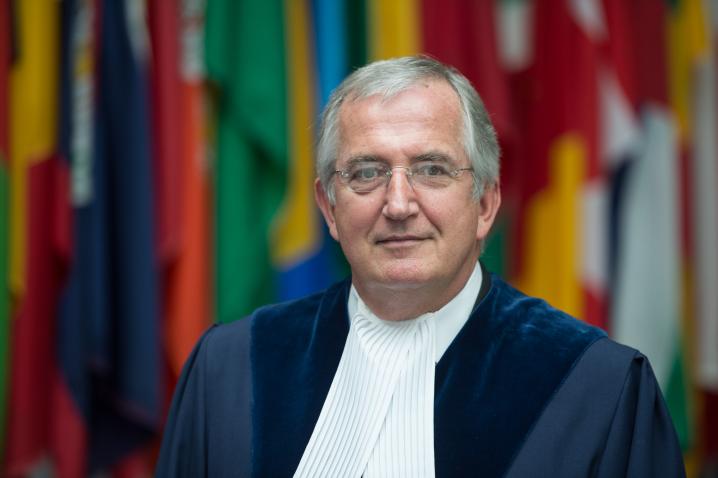It has been 25 years since the International Tribunal for the Law of the Sea was inaugurated in the Free and Hanseatic City of Hamburg, Germany, in October 1996. The establishment of the Tribunal as the keystone of the dispute-settlement procedure laid down in the United Nations Convention on the Law of the Sea (the Convention) opened a new chapter in the peaceful settlement of disputes. For the first time, a specialized tribunal of 21 judges was seated to assist parties in resolving disputes related to the interpretation and application of the Convention or indeed any other agreement conferring jurisdiction upon it.
Just a year after the Tribunal began its work, Saint Vincent and the Grenadines invoked the compulsory jurisdiction of the Tribunal in a prompt release case relating to the seizure of the tanker M/V “Saiga” and the detention of its crew by Guinean authorities. Since that first case, disputes submitted to the Tribunal have varied widely both in the subject matter brought before the bench and in the procedures used. The occasion of the twenty-fifth anniversary of the founding of the Tribunal provides a valuable opportunity to reflect on its work to date and acknowledge its contribution both to dispute settlement under the Convention and the progressive development of the law of the sea.
When reviewing a span of 25 years of jurisprudence, there are, of course, highlights that spring to mind. Some relate to the successful resolution of a dispute in which the Tribunal has clearly helped bring States back to the negotiating table, or enabled them to work together peacefully and constructively. One such example can be seen in the Land Reclamation Case (Malaysia v. Singapore), in which the Tribunal prescribed provisional measures to promote an exchange of information and cooperation between the parties. The Tribunal also requested the parties to establish a group of independent experts to determine the consequences of the land reclamation work conducted by Singapore and propose appropriate actions to deal with any adverse effects. On this basis, the parties reached an agreement bringing to an end the proceedings on the merits. Thus, by guiding the parties’ future conduct and helping to lay the groundwork for a negotiated settlement, the resolution of the dispute was achieved through the prescription of provisional measures alone.
Other highlights include decisions that have underscored the progressive development of international law by providing clarification in areas not specifically addressed by the Convention. Any reader of the Tribunal’s decisions will find important clarifications of core concepts, including that of “the ship as a unit”, the “genuine link” and “nationality of claims” for the purpose of exercising flag State protection and gaining insights into the obligations incumbent on flag States. Similarly, decisions rendered in delimitation cases before the Tribunal relating to the entitlement of a coastal State to a continental shelf beyond 200 nautical miles and to the concept of natural prolongation are of note.
On a personal level, I consider the rendering of the advisory opinion concerning the responsibilities and obligations of sponsoring States with respect to activities in the Area (the seabed and ocean floor and subsoil thereof, beyond the limits of national jurisdiction) to be a landmark moment. Delivered in 2011 by a unanimous decision of the Tribunal’s Seabed Disputes Chamber, the advisory opinion set out the obligations of sponsoring States and established the conditions under which their liability would arise. In doing so, it provided important clarification of some of the most difficult aspects of the Convention concerning the exploration and exploitation of the mineral resources of the deep seabed. The advisory opinion was widely welcomed within the framework of the International Seabed Authority and had a major influence on States’ willingness to sponsor activities in the Area.

Another milestone was achieved when the Tribunal rendered its advisory opinion to the member States of the Sub-Regional Fisheries Commission, clarifying the obligations and liability of flag States whose vessels are engaged in illegal, unreported and unregulated (IUU) fishing activities in their exclusive economic zones. Once again, the advisory opinion was well received and seen as a significant contribution to the prevention of IUU fishing and to the sustainable management of fisheries.
Both of these advisory opinions have been instrumental in strengthening the protection of the marine environment. In my view, the full potential of the advisory jurisdiction of the Tribunal has yet to be realized. In many situations, a binding decision may not necessarily be the appropriate tool for clarifying particular legal questions. I would expect to see greater interest in such instances in the coming 25 years.
Looking back at the Tribunal of 1996 and comparing it with the bench we have today, it is evident that much has changed. Of the 21 judges who took their oath at the inauguration ceremony in Hamburg City Hall, in the presence of then United Nations Secretary-General Boutros Boutros-Ghali, many could be described as architects of the Convention owing to their longstanding involvement in the drafting process. While the geographical diversity of the bench has always been assured, in accordance with the Statute of the Tribunal, we now see an even more heterogeneous group of judges. Today, the bench reflects a greater diversity, not only in terms of gender and age but also in relation to the judicial systems, education and the experience the judges bring with them. This is a most welcome development.
Our oceans have never played a more significant role in all spheres of human life and endeavour as they do today. It is only through sound governance of the oceans that we will continue to reap the benefits of this common good while preserving it for generations to come. Serious issues affecting oceans include the impacts of climate change, such as sea-level rise, ocean acidification and ocean warming; the growing interest in deep-sea resources from polymetallic nodules to marine genetic resources; the move towards the exploitation of blue energy; and the protection and preservation of the marine environment. All of these topics—and indeed many more—could well constitute reasons for States or intergovernmental organizations to call upon the Tribunal to exercise either its contentious or its advisory jurisdiction.
I know that I speak for every judge on the bench in saying that we stand ready to serve the international community in helping uphold and safeguard global ocean governance as embodied in the Convention.
The UN Chronicle is not an official record. It is privileged to host senior United Nations officials as well as distinguished contributors from outside the United Nations system whose views are not necessarily those of the United Nations. Similarly, the boundaries and names shown, and the designations used, in maps or articles do not necessarily imply endorsement or acceptance by the United Nations.




